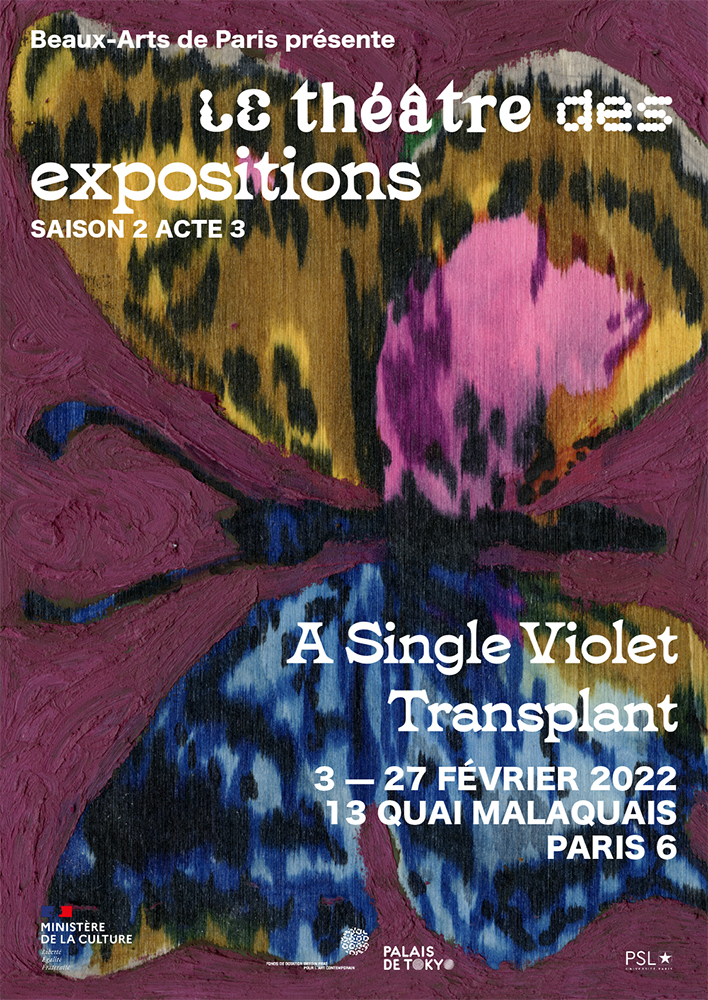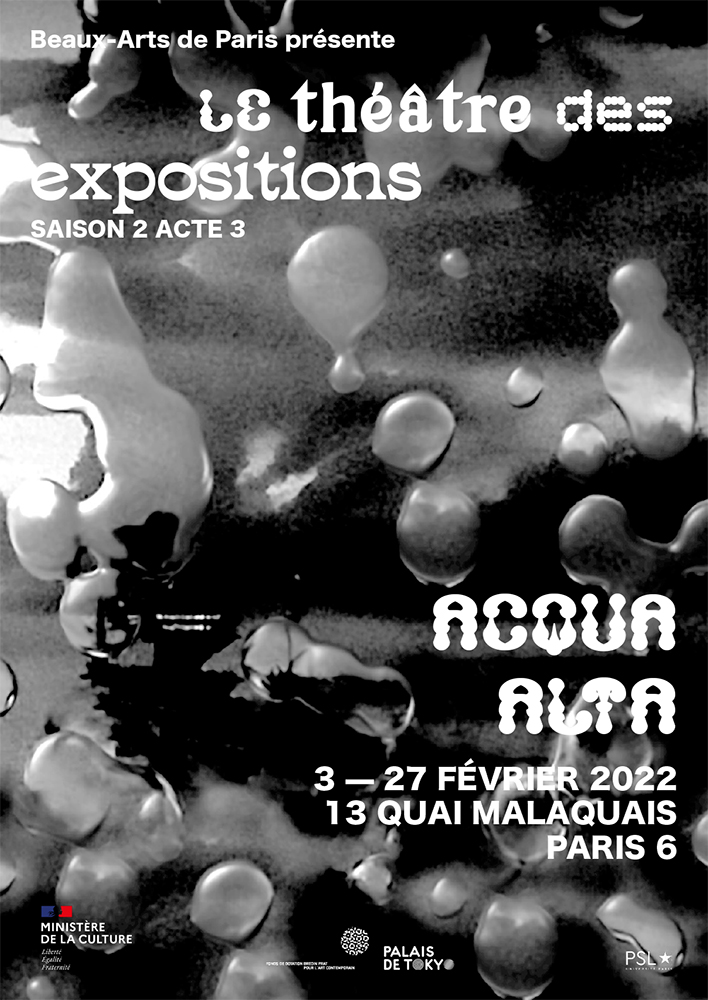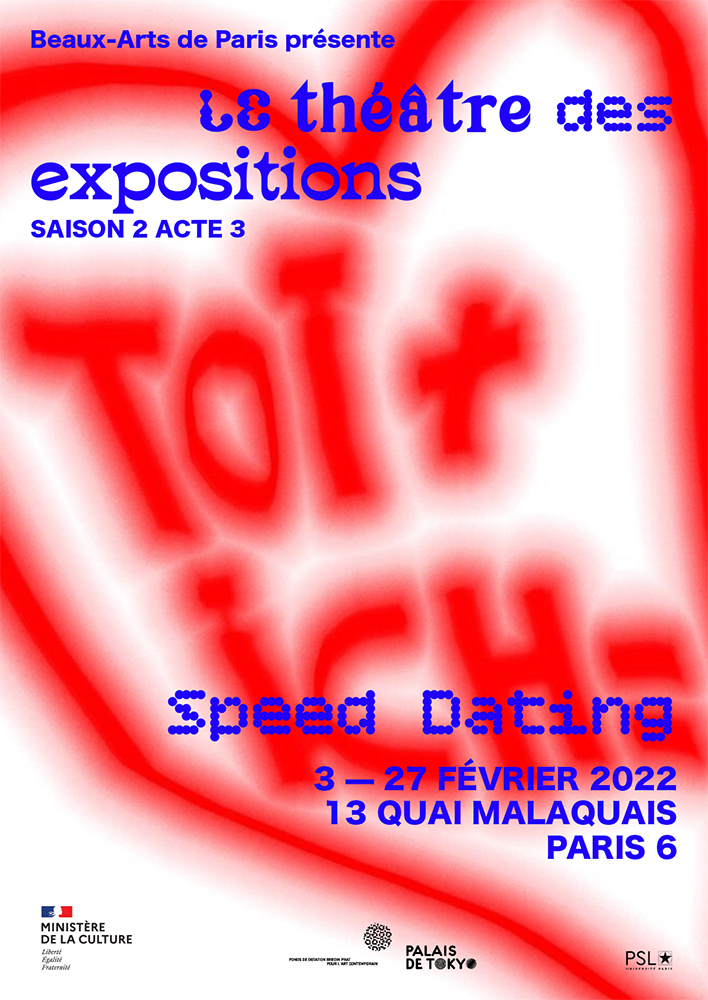The four exhibitions of Act 3 have in common a love of the living. They demonstrate a desire to experiment with other ways of being attentive to the complexity and intensity of life, and to speculate on the future. Each of them proposes to bring the School's collections into dialogue with the outside world in its own way.
Speed Dating proposes a meeting between the painters of the Nina Childress studio at the Beaux-Arts de Paris and those of the Beaux-Arts de Dresden (HfBK). Emblematic works from the collections of the Beaux-Arts de Paris, awarded in the context of the Torso competition created in 1784 and the Jauvin d'Attainville prize founded in 1877, disrupt this meeting. Acqua Alta writes the scenario of a future immersed under water, after the apocalypse. In a contaminated world where the living would have flourished again, A Single violet transplant follows the advice of Silvia Federici, academic, teacher and activist: "The mistake is to give ourselves unattainable goals and always fight 'against' rather than trying to build something". Finally, The Call draws the landscape left by a pack of artists. Between the forest and the hut, these are presences/absences that invite you to wander.
Act 3 of the Theatre of Exhibitions is created by the third class of 2021-22 of the "Artists & Exhibition Professions" course at the Beaux-Arts de Paris. Fifteen student artists from the School are working in groups with six curators associated with the programme to support and develop exhibition projects. But more than exhibitions in the strict sense of the word, it is above all a process, a research and a sharing of ideas.
Act 3 will be punctuated by numerous events: speed dating for single artists, concerts, performances, readings... A common bilingual booklet will bring them together to present them.
The visual identity was designed by Caroline Rambaud, Margot Bernard and Glenn Espinoza, students in the programme.
Practical information :
Opening on Wednesday 2 February 2022 from 6pm to 9pm
A health pass and a mask must be worn.
A Single Violet Transplant
Between you and me, we know very well that it is a much bigger desert crossing than we are led to believe. You planted a large poisonous meadow, surrounded by purple and spit on the ground. You are also the mother of every flower we see in this contaminated field.
When I ask you why you chose this colour, you tell me that it is not even a primary colour and that this colour is therefore not often found in nature. You chose purple because it's a colour on the edge of the rainbow, it makes me think of us. You explain to me that the image is stronger than the language, it is true for you who speak with dragonflies and bees. You can hear the electrical rumours of each insect, the same as those of the welds on metal. The falls and aspirations of ruined architectures, the sound of the rails trying to warn you.
You explain to me that the dream of every artist is to create something that changes the way someone functions, I am deeply convinced of this. You know your works only in your dreams and yet you know that they will see the light of day.
They are your daughters and your white hair, they are the great muffled cries of pain. They are the nettles that grow at the foot of the big wastelands near the social housing.
Your hands are dirty from wax and plaster, and you leave your shoes lying around. But the ghosts of yesterday you replace one by one. You watch the rain wash your hands, you know that thanks to your work everything will be clear, that the steel barriers are already beginning to be eaten away by the soft wax. No miracle, only step after step. The beating of the wings of gynandromorph butterflies washing out the vicious air that men spit out.
I receive a photograph of a heart transplant, a heart that continues to beat in a small plastic box. After this operation, the body continues to function but it functions differently. You kept talking to me about this image of a purple transplant, you didn't even think that it also meant potting violets even though you speak English.
Based on a proposal by Emma Passera, curator associated with the "Artists & Exhibition Professions" programme, with Anousha Mohtachmi and Clara Midon, students in the programme.
Artists presented: Sofia Bonilla, Inès Cherifi, Mimosa Echard, Victor Gogly, Lucas Hadjam, Dylan Maquet, Clara Midon, Anousha Mohtashama, Winnie Mo Rielly, Francisco G. Pinzon Samper, Sequoia Scavullo and an anonymous person.
Acqua Alta
Paris 2019,
The Defence Innovation Agency, the Armed Forces Staff, the Directorate General for Armaments, International Relations and Strategy are all out of ideas. What will the world look like in thirty years? And in sixty years? Where will the threat come from? From the sea?
Yes, probably. The waters have already begun their slow and terrible rise. Who can say what will happen when the face of the continents changes? No one can. Unless a tiny portion of the population can show foresight.
So, answering the call, science fiction authors and artists join the group of scientific and military experts already assembled. The team is complete. The mission's code name: Acqua Alta. Their goal? To write scenarios, produce artefacts and, above all, to undermine the army by predicting the future of war and revolution. Together they are writing the scenario of what will happen when the oceans and seas invade the shores of our continents. The meeting has just ended, everyone is catching their breath by the coffee machine.
The exhibition is inspired by real events.
Based on a proposal by Grégoria Lagourgue, curator associated with the course, accompanied by Jean-Baptiste Georjon, Mara Thevenet, Caroline Rambaud, Clarisse Marguerite, Joséphine Berthou, Amandine Massé and Margot Bernard, students in the "Artists & Exhibition Professions" course.
Set design by Julien Calas, Coralie Coralie Gérardin and Raphael Tétreault-Boyle, students of the École supérieure d'architecture Paris-Malaquais.
Artists presented: Clarisse Aïn, Gilad Ashery, Quentin Chambaz, Armand Corcelles, Frederik Exner Carstens, Anna Massiot, Para Data, Chloé Cordiale, Mathieu Sauvat, Liv Shulman, Radouan Zeghidour and others.
L'Appel
"I cry wolf.
Wolf are you there, can you hear me?
The exhibition The Call takes the title of Jack London's 1903 short story: The Call of the Wild. It is the epic story of a driving dog in the Great Arctic North, during which the crossings of the wild forests awaken in him his wolf instinct.
The call manifests itself in an immaterial and sensitive way. It is the feeling of being traversed by an invisible and indescribable element. In the story, the call is the howling of the wolf. It provokes an unalterable force in the dog, which mobilises him to follow the pack, whose every yap draws him in. It is like the need to return to the primitive.
In the exhibition, the dogs are alone, melancholic, on the prowl or gathered during a hunt in the heart of the woods. The posture of the dog is summoned by a muffled call of the wolf between the photographs, as if it were hiding somewhere. The same is true of the presence of other wild animals: vaporous or hidden.
Finally, the human presence is also real, although at first sight it is not apparent. For behind the dogs, and behind the wolves themselves, there is someone. The forest and all that it envelops beckon us. Its silence is a lure because the call, however mysterious, also comes from simple movements, brushes, glances and shivers. Alone in the woods, all eyes are on us and we are all looking at them too: visibly invisible.
Based on a proposal by Eugénie Touzé, associate curator of the course, assisted by Margot Bernard, Zoé Bernardi, Amandine Massé and Fanny Irina Sinecoin, students in the "Artists & Exhibition Professions" course. With the collaboration of Anne-Marie Garcia, curator of photographs and prints, responsible for the collections at the Beaux-Arts de Paris.
Artists presented: Dorine Bernard, Margot Bernard, Mathilde Cazes, Louise Covillas, Myriame El Khawaga, A. Foncelle, Pauline de Fontgalland, Agnès Geoffray, Victor Giannotta, Arthur Guespin, Hélène Janicot, Henri Langerock, Luc-Andréa Lauras, Vincent Laval, Louise Le Pape, Jules Lobgeois, Tamara Morisset, Céleste Philippot, Alexandre Poisson, Eugénie Touzé, and anonymous artists
Speed Dating
The exhibition Speed Dating is the result of pictorial encounters framed by a protocol imagined between the students of the Nina Childress studio at the Beaux-Arts de Paris and the Beaux-Arts de Dresden (HfBK).
Designed especially for the exhibition, the paintings are associated in diptychs of the same format in order to initiate a fertile dialogue between French and German studios. Although these combinations may seem formal at first glance, they are part of an "aesthetic of the encounter", in which each meeting ends up revealing unsuspected facets of the paired paintings. Their possible complementarity is the result of a collaborative curatorial experiment lasting several days which aims to test the intertwining of their respective references, styles and techniques.
In an exhibition space conceived as a romantic arena that is constantly reconfigured, the spectators become the witnesses - and sole judges - of relationships that can be both promising and doomed to failure.
Works from the collections of the Beaux-Arts de Paris, winners of the Torso competition created in 1784 and of the Jauvin d'Attainville prize founded in 1877, take part in these exchanges and offer a transhistorical vision of the treatment of a motif that is imposed but constantly reinterpreted over the centuries.
Based on a proposal by Vincent Enjalbert and Violette Morisseau, associate curators of the course, accompanied by Charline Gdalia, Clarisse Marguerite and Fanny Sinedin, students in the "Artists & Exhibition Professions" course.
Atelier Nina Childress, Beaux-Arts de Paris: Eilert Asmervik, Juliette Barthe, Adrien Boris, Marius Buet, Louis Clozier, Carolina De La Roche, Anabel Dubois Gance, Blair Ekleberry, Mina Ferrari, Olivier Lepront, Violette Malinvaud, Marie-Cécile Marques, Samya Moineaud, Laure Pinard, Mathilde Puig, Lou Olmos Arsenne, Rose Ras, Angèle Rose, Lea Simhony and Gabrielle Simonpietri.
Hochschule für Bildende Künste, Dresden : Sofia Antoniadou, Anna Ditscherlein, Lena Dobner, Nima Emami, Carolin Israel, Eric Keller, Joo Young Kim, Jana Lütkewitte, Maria del Mar Sánchez Expósito, Lena Melis Koneberg, Annike Nannt, Lucas Oertel, Katrina L. Pennington, Ana Pireva, Aren Shahnazaryan, Sarah Steuer, Lea Tofharn, Quang Tran, Jan Christoph Wagner, Felina Wießmann
With Mohammed Abou-Kalam, Louis Anselme Grosdidier, Suzanne-Emma-Aline Deguy and René-Marie-Joseph Castaing.

A SINGLE VIOLET TRANSPLANT

ACQUA ALTA

L'APPEL

SPEED DATING




